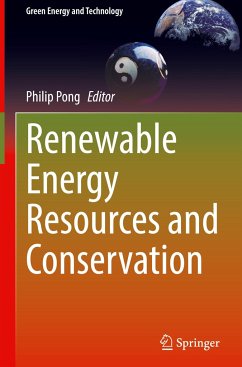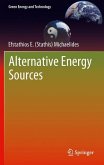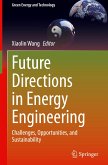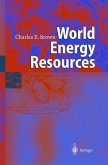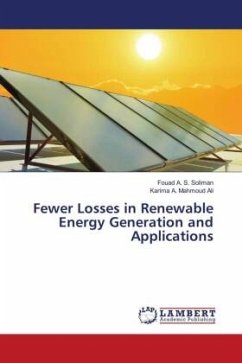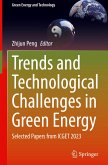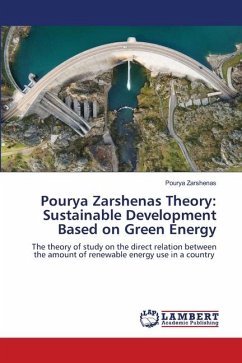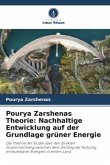Renewable Energy Resources and Conservation
Herausgegeben:Pong, Philip
Renewable Energy Resources and Conservation
Herausgegeben:Pong, Philip
- Gebundenes Buch
- Merkliste
- Auf die Merkliste
- Bewerten Bewerten
- Teilen
- Produkt teilen
- Produkterinnerung
- Produkterinnerung
This book offers a comprehensive overview of state-of-the-art research and development in diverse areas of renewable energy, including renewable energy storage, conservation, solar, wind, biomass, nuclear, geothermal, and renewable energy systems. It is a valuable resource for anyone interested in gaining insight into the latest advancements in renewable energy technologies and their applications. The book chapters present selected high-quality research from the 8th International Conference on Renewable Energy and Conservation (ICREC 2023) that analyze the latest trends and present case…mehr
Andere Kunden interessierten sich auch für
![Alternative Energy Sources Alternative Energy Sources]() Efstathios E. Michaelides (Stathis)Alternative Energy Sources82,99 €
Efstathios E. Michaelides (Stathis)Alternative Energy Sources82,99 €![Future Directions in Energy Engineering Future Directions in Energy Engineering]() Future Directions in Energy Engineering90,99 €
Future Directions in Energy Engineering90,99 €![World Energy Resources World Energy Resources]() Charles E. BrownWorld Energy Resources153,99 €
Charles E. BrownWorld Energy Resources153,99 €![Fewer Losses in Renewable Energy Generation and Applications Fewer Losses in Renewable Energy Generation and Applications]() Fouad A. S. SolimanFewer Losses in Renewable Energy Generation and Applications45,99 €
Fouad A. S. SolimanFewer Losses in Renewable Energy Generation and Applications45,99 €![Trends and Technological Challenges in Green Energy Trends and Technological Challenges in Green Energy]() Trends and Technological Challenges in Green Energy112,99 €
Trends and Technological Challenges in Green Energy112,99 €![Pourya Zarshenas Theory: Sustainable Development Based on Green Energy Pourya Zarshenas Theory: Sustainable Development Based on Green Energy]() Pourya ZarshenasPourya Zarshenas Theory: Sustainable Development Based on Green Energy40,99 €
Pourya ZarshenasPourya Zarshenas Theory: Sustainable Development Based on Green Energy40,99 €![Pourya Zarshenas Theorie: Nachhaltige Entwicklung auf der Grundlage grüner Energie Pourya Zarshenas Theorie: Nachhaltige Entwicklung auf der Grundlage grüner Energie]() Pourya ZarshenasPourya Zarshenas Theorie: Nachhaltige Entwicklung auf der Grundlage grüner Energie60,90 €
Pourya ZarshenasPourya Zarshenas Theorie: Nachhaltige Entwicklung auf der Grundlage grüner Energie60,90 €-
-
-
This book offers a comprehensive overview of state-of-the-art research and development in diverse areas of renewable energy, including renewable energy storage, conservation, solar, wind, biomass, nuclear, geothermal, and renewable energy systems. It is a valuable resource for anyone interested in gaining insight into the latest advancements in renewable energy technologies and their applications. The book chapters present selected high-quality research from the 8th International Conference on Renewable Energy and Conservation (ICREC 2023) that analyze the latest trends and present case studies.
Renewable Energy Resources and Conservation offers researchers, practitioners, professionals, and scientists working in renewable energy engineering a host of authoritative ideas and insights into renewable energy grid infrastructures, engineering design methods, technologies, and best practices to address industrial challenges.
Renewable Energy Resources and Conservation offers researchers, practitioners, professionals, and scientists working in renewable energy engineering a host of authoritative ideas and insights into renewable energy grid infrastructures, engineering design methods, technologies, and best practices to address industrial challenges.
Produktdetails
- Produktdetails
- Green Energy and Technology
- Verlag: Springer / Springer Nature Switzerland / Springer, Berlin
- Artikelnr. des Verlages: 978-3-031-59004-7
- 2024
- Seitenzahl: 260
- Erscheinungstermin: 6. Juli 2024
- Englisch
- Abmessung: 241mm x 160mm x 20mm
- Gewicht: 502g
- ISBN-13: 9783031590047
- ISBN-10: 303159004X
- Artikelnr.: 70209219
- Herstellerkennzeichnung
- Springer-Verlag GmbH
- Tiergartenstr. 17
- 69121 Heidelberg
- ProductSafety@springernature.com
- Green Energy and Technology
- Verlag: Springer / Springer Nature Switzerland / Springer, Berlin
- Artikelnr. des Verlages: 978-3-031-59004-7
- 2024
- Seitenzahl: 260
- Erscheinungstermin: 6. Juli 2024
- Englisch
- Abmessung: 241mm x 160mm x 20mm
- Gewicht: 502g
- ISBN-13: 9783031590047
- ISBN-10: 303159004X
- Artikelnr.: 70209219
- Herstellerkennzeichnung
- Springer-Verlag GmbH
- Tiergartenstr. 17
- 69121 Heidelberg
- ProductSafety@springernature.com
Philip Pong, Ph.D., is an Associate Professor of Electrical and Computer Engineering at the New Jersey Institute of Technology, where he is the Director of the Green Technology Research and Training Laboratory and Sensor Research Laboratory. He received a B.Eng. from the University of Hong Kong (HKU) with 1st class honours, followed by a Ph.D. in engineering at the University of Cambridge. Dr. Pong was a three-year postdoctoral researcher with the Magnetic Materials Group at the National Institute of Standards and Technology (NIST). His research interest currently focuses on developing and applying advanced sensing techniques based on electromagnetic sensors in smart grids, smart cities, and wind power. Dr. Pong is a Fellow of the Institution of Engineering and Technology (FIET), the Institute of Physics (FInstP), the Energy Institute (FEI), the Institute of Materials, Minerals, and Mining (FIMMM), and the Hong Kong Institution of Engineers (FHKIE). He is a chartered physicist (CPhys), a chartered engineer (CEng), a chartered energy engineer, a registered professional engineer (R.P.E. in Electrical, Electronics, Energy), and a Senior Member of the IEEE (SMIEEE). He serves on the editorial boards for several IEEE and SCI journals.
Part 1 Solar Energy and Photovoltaic Power Generation.- Chapter 1 Artificial Neural Network Application for the Prediction of Global Solar Radiation inside a Greenhouse.- Chapter 2 Prototype of a Solar Photovoltaic Charging Station Applied to the Propulsion of Artisanal Fishing Vessels in Arequipa, Peru.- Chapter 3 Evaluation and Improvement of the Efficiency of a Self-Contained Photovoltaic System Applied to a Small Business in Arequipa, Peru.- Chapter 4 Feasibility Study of a Sustainable Roof Top Domestic Solar Energy System in the UK.- Chapter 5 Effect of 2023 European Heatwave on Photovoltaic Energy Generation: A Case Study of Central and Southern Italy.- Chapter 6 Classification of Types of Daily Solar Radiation Patterns Using Machine Learning Techniques.- Chapter 7 Optimizing Energy Savings in Polyisoprene Production Through Solar-Based Thermal Technology.- Part 2 Clean Energy Technology and Emission Reduction.- Chapter 8 Hydrogen Fuel for A Sustainable Aviation.- Chapter 9 Experimental Evaluation of a Prototype for the Micro Production of Green Hydrogen.- Chapter 10 Stochastic Simulation of Wind Power Profiles from Time Series Analysis Considering Dependencies on Meteorological Variables.- Chapter 11 Short-term Scheduling of Support Vessels in Wind Farm Maintenance.- Chapter 12 Privacy-Preserving Energy Trading with Applications to Renewable Energy Communities.- Chapter 13 Use of Watermelon Waste as a Fuel Source for Bioelectricity Generation.- Chapter 14 Scenario Analysis on Deployment of Clean Liquid Fuels in Japan toward Decarbonizing Energy Systems.- Chapter 15 Assessing Carbon Footprint Estimations of ChatGPT.- Part 3 Waste-to-Energy and Microbial Fuel Cell Technology.- Chapter 16 New Fuel Source: Lemon Waste in MFCs-SC for the Generation of Bioelectricity.- Chapter 17 Eco-friendly Generation of Electricity Using the Bacteria Proteus Vulgaris as a Catalyst.- Chapter 18 Multiple Block-shaped Vertical Cathodes for Scale-up of Floating Microbial Fuel Cells.- Chapter 19 Exploring Liquefied Dimethyl Ether for Lipid Extraction from Fat Balls in Wastewater Pumping Stations.- Chapter 20 Generation of Electrical Energy through Microbial Fuel Cells Using Beet Waste as Fuel.- Part 4 Waste Heat Utilization and Energy Conservation.- Chapter 21 Effect of a Movable Phase Change Materials (PCMs) Layer on Lowering Energy Usage in Desert Structures.- Chapter 22 Energy Optimization Analysis and Case Study of Commercial Buildings Using EnergyPlus.- Chapter 23 Evaluation and Identification of Waste Heat Utilization Pathways: A Review.- Chapter 24 Evaluation of An Heat Pump Integration in the District Heating Supply of a Production Facility.- Part 5 Distributed Energy Resources Based Microgrid and Battery Energy Storage Technology.- Chapter 25 Assessing Economic Performance of An Energy Microgrid: A Conditional Value-at-Risk Optimization Approach.- Chapter 26 Study of the Behavior of an Electric Power Generation System with AGM Battery Storage Using Sankey Diagrams.- Chapter 27 Electro-Acoustic Charging Prolongs the Cycle Life of Lead-Acid Battery Cells.
Part 1 Solar Energy and Photovoltaic Power Generation.- Chapter 1 Artificial Neural Network Application for the Prediction of Global Solar Radiation inside a Greenhouse.- Chapter 2 Prototype of a Solar Photovoltaic Charging Station Applied to the Propulsion of Artisanal Fishing Vessels in Arequipa, Peru.- Chapter 3 Evaluation and Improvement of the Efficiency of a Self-Contained Photovoltaic System Applied to a Small Business in Arequipa, Peru.- Chapter 4 Feasibility Study of a Sustainable Roof Top Domestic Solar Energy System in the UK.- Chapter 5 Effect of 2023 European Heatwave on Photovoltaic Energy Generation: A Case Study of Central and Southern Italy.- Chapter 6 Classification of Types of Daily Solar Radiation Patterns Using Machine Learning Techniques.- Chapter 7 Optimizing Energy Savings in Polyisoprene Production Through Solar-Based Thermal Technology.- Part 2 Clean Energy Technology and Emission Reduction.- Chapter 8 Hydrogen Fuel for A Sustainable Aviation.- Chapter 9 Experimental Evaluation of a Prototype for the Micro Production of Green Hydrogen.- Chapter 10 Stochastic Simulation of Wind Power Profiles from Time Series Analysis Considering Dependencies on Meteorological Variables.- Chapter 11 Short-term Scheduling of Support Vessels in Wind Farm Maintenance.- Chapter 12 Privacy-Preserving Energy Trading with Applications to Renewable Energy Communities.- Chapter 13 Use of Watermelon Waste as a Fuel Source for Bioelectricity Generation.- Chapter 14 Scenario Analysis on Deployment of Clean Liquid Fuels in Japan toward Decarbonizing Energy Systems.- Chapter 15 Assessing Carbon Footprint Estimations of ChatGPT.- Part 3 Waste-to-Energy and Microbial Fuel Cell Technology.- Chapter 16 New Fuel Source: Lemon Waste in MFCs-SC for the Generation of Bioelectricity.- Chapter 17 Eco-friendly Generation of Electricity Using the Bacteria Proteus Vulgaris as a Catalyst.- Chapter 18 Multiple Block-shaped Vertical Cathodes for Scale-up of Floating Microbial Fuel Cells.- Chapter 19 Exploring Liquefied Dimethyl Ether for Lipid Extraction from Fat Balls in Wastewater Pumping Stations.- Chapter 20 Generation of Electrical Energy through Microbial Fuel Cells Using Beet Waste as Fuel.- Part 4 Waste Heat Utilization and Energy Conservation.- Chapter 21 Effect of a Movable Phase Change Materials (PCMs) Layer on Lowering Energy Usage in Desert Structures.- Chapter 22 Energy Optimization Analysis and Case Study of Commercial Buildings Using EnergyPlus.- Chapter 23 Evaluation and Identification of Waste Heat Utilization Pathways: A Review.- Chapter 24 Evaluation of An Heat Pump Integration in the District Heating Supply of a Production Facility.- Part 5 Distributed Energy Resources Based Microgrid and Battery Energy Storage Technology.- Chapter 25 Assessing Economic Performance of An Energy Microgrid: A Conditional Value-at-Risk Optimization Approach.- Chapter 26 Study of the Behavior of an Electric Power Generation System with AGM Battery Storage Using Sankey Diagrams.- Chapter 27 Electro-Acoustic Charging Prolongs the Cycle Life of Lead-Acid Battery Cells.

